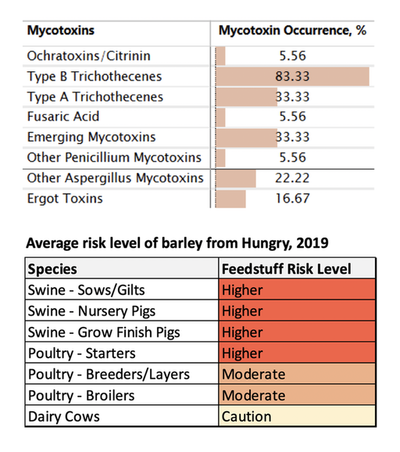European Harvest Analysis Information
HUNGARY:BarlEy
Barley samples from Hungary for the 2019 harvest contained an average of 2.9 mycotoxins per sample. Notable mycotoxins include the type B trichothecenes family (DON group) at an 83% occurrence rate, an average level of 1176 ppb in positive samples and a maximum of 6444 ppb detected overall. A variety of type B trichothecene family members were present in these samples, including deoxynivalenol (DON, 83%), 3-acetyl-DON, 15-acetyl-DON, DON-3-glucoside and fusarenon X.
Type A trichothecenes (T2/HT2-toxin group), emerging mycotoxins and Aspergillus mycotoxins were detected in a portion of these samples, but were generally at lower levels of concentration.
The most significant weather event contributing to mold and mycotoxin production in small grains across Hungary, was surplus rainfall. The rainfall was in surplus May through July and is a major precursor to Fusarium mold growth. Fusarium graminearum is the major producer of Type B Trichothecenes. Fusarium species also produce the type A trichothecenes.
Poultry breeders/layers:Green < 20;Yellow/Orange 20 - 80;Red > 80
Sows/gilts/boars: Green < 20;Yellow/Orange 20 - 50;Red > 50
Number of samples: 18
Date range: July to September, 2019
VIEW GRAPHICAL SUMMARY
European Harvest Analysis Information
HUNGARY:BarlEy
2.9
mycotoxins average per sample
88.9%
contain mycotoxins
0-6
mycotoxins in samples
